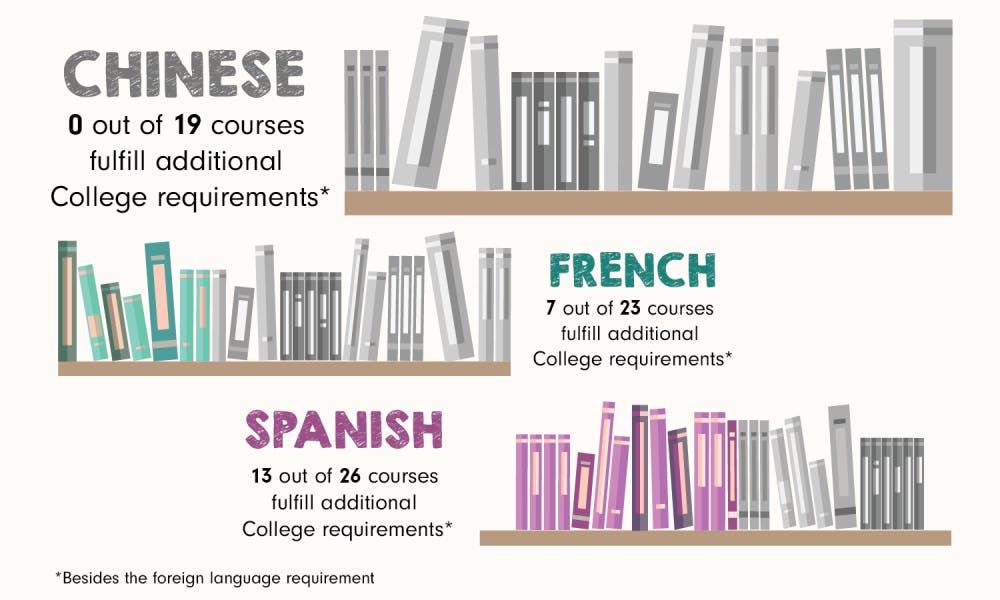
Penn students have said that a lack of course information can make academic planning difficult, and many had to grapple with those challenges as they prepared for the opening of spring 2018 course registration on Nov. 29.
During this period, students in the College of Arts and Sciences not only need to consider requirements from their majors, but they will also need to find ways to fulfill seven sector requirements in order to graduate. However, this has not always been the case.
Prior to 1987, requirements in the College were based on a distributional system with three divisions: humanities, social sciences, and natural sciences.
Students in the College were required to take three courses from each of the three divisions, but courses were not individually selected to fulfill certain divisional requirements. Rather, entire departments would satisfy certain requirements — in contrast to the current situation, where only specific classes within departments can fulfill requirements. For example, despite the similarity in names, not all courses in the History Department count toward the History and Tradition sector.
Why do these sector requirements exist?
The School of Arts and Sciences shifted its academic policy in 1987 to reflect a general education requirement system similar to the one that holds today.
At the time, administrators said they had to make this shift in order to "expose [the students] to more of the University," Ivar Berg, then associate dean of SAS, told The Daily Pennsylvanian in 1988.
Berg added that "without structures, students talked to each other [about their classes] and concentrated in a few classes because of the ambiguity of choices." This led to long waitlists for popular courses taken to satisfy the requirements.
Current Associate Dean of the College and Director of Academic Affairs Kent Peterman said that under this system, faculty had difficulty designing courses to best suit undergraduate academic needs, and students had issues deciding which courses to take to fulfill certain requirements. This changed when the College created sector requirements, which call for students to take a single course in each sector.
The classes that satisfy the sector requirements are meant to be introductory, stand-alone courses.
"If that is the only Arts and Letters course you take, you are going to come away from that feeling that ‘Yeah I understand not just this course and the subject matter of this course, but also a whole way of thinking that is kind of embodied in that sector,'" Peterman said.

Why do some courses count for requirements while others don't?
Courses that students find similar do not all count towards these requirements. For example, some students and faculty have expressed frustration that Spanish and French language courses at Penn fulfill sector requirements such as the Arts and Letters sector, while none of the language courses offered under the East Asian Languages and Civilizations Department do.
There are two faculty panels — one that focuses on the first four sectors and another that focuses on the last three — that make the final decision on which courses are deemed suitable to fulfill a sector requirement, Peterman said. The academic departments must submit their own recommendations of courses to be reviewed by the panel. Year to year, however, there is little variation in the courses that fulfill the requirements.
Peterman said if every class fulfilled a requirement, “the list would become so large that it would become incomprehensible,” adding that this would make course selection confusing to advisors as well as students. He also cited this as the reason why not every class in the History Department counts toward the History and Tradition sector.
College senior Catherine O’Donnell said she found this system frustrating, especially given the fact that courses such as Math 114 do not satisfy the Natural Sciences and Mathematics sector.
“The purpose of it is kind of ridiculous because no math course actually counts for it,” O’Donnell said. “Ideas in Mathematics counts, but no actual calculus course does.”
Though students have tried to petition for certain classes to fulfill their requirements, Peterman said the College has “pushed back pretty strenuously on that.” He added that this policy is meant to encourage students to step out of their comfort zones and use the sectors to explore Penn’s course offerings.
“We have such diversity of content that there is some other place that they could go that would broaden their education, and we think that they should do that,” he said.
The Daily Pennsylvanian is an independent, student-run newspaper. Please consider making a donation to support the coverage that shapes the University. Your generosity ensures a future of strong journalism at Penn.
Donate




